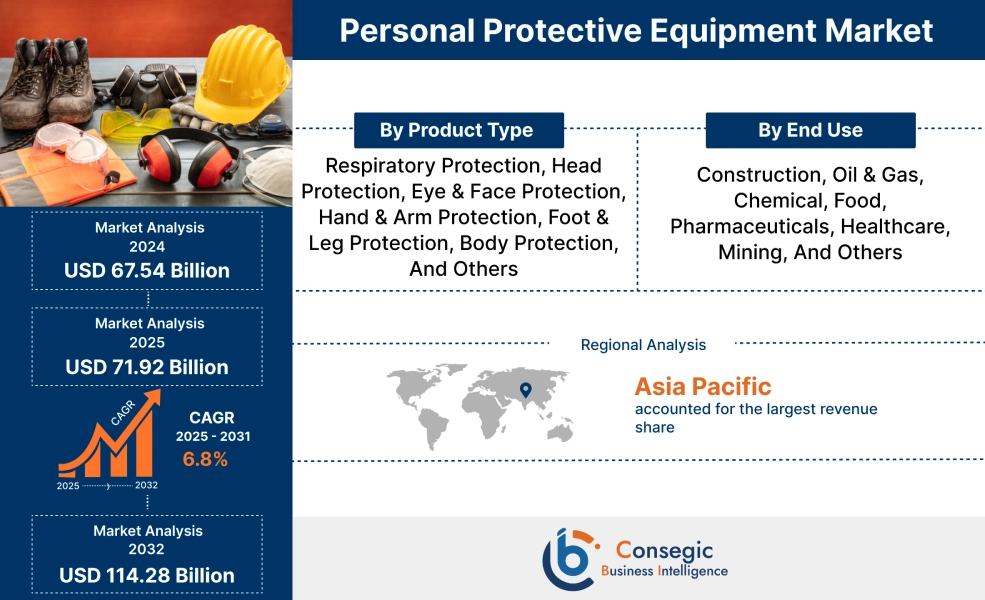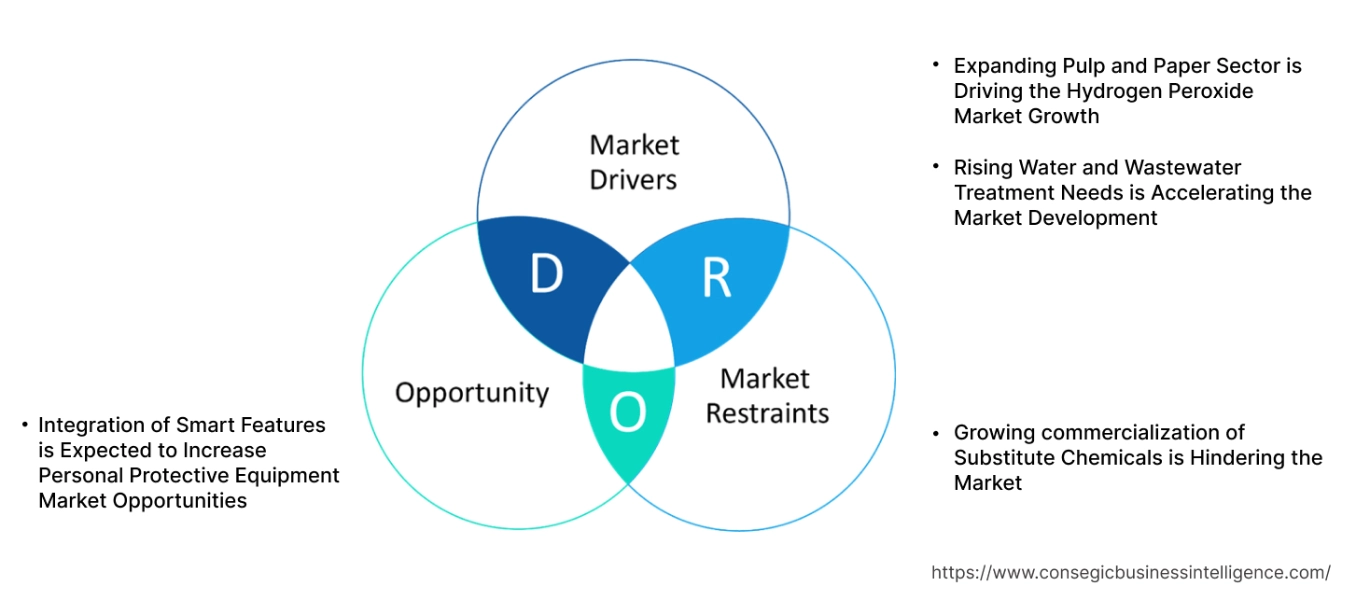Personal Protective Equipment Market Size:
Personal Protective Equipment Market size is growing with a CAGR of 6.8% during the forecast period (2025-2032), and the market is projected to be valued at USD 114.28 Billion by 2032 from USD 67.54 Billion in 2024. Additionally, the market value for the 2025 attributes to USD 71.92 Billion.
Personal Protective Equipment Market Scope & Overview:
Personal protective equipment (PPE) is specialized clothing. It is equipment which is worn by workers acts as a barrier to minimize exposure to hazards. This includes chemical hazards, biological hazards, mechanical hazards, fall hazards, thermal hazards, and noise hazards among others. Its manufacturing starts with the designing for specific hazards and selecting appropriate materials. Later, precise cutting, shaping, and assembly are performed. The equipment is also tested to ensure it is compliant with stringent safety standards. Polycarbonate, high-density polyethylene, Kevlar, and latex among others are the common materials used in the manufacturing of this equipment. The equipment finds application across various industries such as construction, healthcare, and chemicals among others.
How is AI Transforming the Personal Protective Equipment Market?
AI is significantly used in the personal protective equipment (PPE) market, primarily for facilitating smart PPE with enhanced features, automated real-time monitoring for compliance and safety, predictive analytics for proactive risk management, and improved PPE design through data-driven insights and advanced materials. Moreover, AI systems use computer vision and video analytics to monitor workplaces, identify safety breaches, and automatically alert supervisors or provide immediate guidance to workers who are not wearing the required safety gear. This automation increases accuracy, reduces human error, and ensures adherence to safety regulations, particularly in environments such as factories, construction sites, and healthcare facilities. Consequently, the above factors are expected to positively impact the market growth in upcoming years.
Personal Protective Equipment Market Dynamics - (DRO) :
Key Drivers:
Rise in Occupational Accidents and Fatalities is Accelerating Personal Protective Equipment Market Expansion.
Personal protective equipment is important for workplace safety. It protects individuals from injuries and illnesses, stemmed from chemical, physical or biological agents. There is rapid industrialization globally, and especially in developing regions, the implementation of adequate safety infrastructure is compromised. Companies are involved in the integration of new technologies without understanding the new hazards. Moreover, there are many accidents stemming from the insufficient training on handling hazardous tasks. All these factors have contributed to the rise in occupational accidents, hence requiring this equipment for protection purposes.
For instance,
- According to the Bureau of Labor Statistics, the fatal work injuries in United States increased by 5.7% in 2022 when compared to previous year, thus positively impacting personal protective equipment market trends.
Overall, the rise in occupational accidents and fatalities is significantly boosting the personal protective equipment market expansion.
Increasing Awareness of Workplace Safety is Driving the Market.
There are safety awareness programs launching on topics such as how to avoid occupational injuries and why a safe workplace is important among others. This has driven companies to recognize a strong safety culture. To improve employee morale and enhance overall productivity of the company, employers are heavily investing in high-quality protective equipment. They are improving communication and transparency, by providing more training and awareness to employees, hence driving more demand.
For instance,
- In 2024, United Rentals launched a new excavation safety training, designed to enhance compliance and productivity in excavation work, also highlighting important role of protective system, thus positively impacting the personal protective equipment market trends.
Thus, increasing awareness of workplace safety is accelerating the global personal protective equipment market growth.
Key Restraints:
High Cost is Hampering the Personal Protective Equipment Market Demand.
While personal protective equipment offers multiple advantages, the development of it is quite expensive. The feature of providing superior protection against hazards involves significant investment in research and development, as it includes the incorporation of cutting-edge materials. It also requires testing and certification processes. This adds up to the manufacturing costs, becoming the reason equipment being costly. Large corporations have dedicated safety budgets; however, SMEs have limited budget and work on tight operational margins. The high cost of the equipment delays the adoption of optimal safety gear, leading to slower growth in the market. Additionally, cheaper and low-quality equipment offers less effectiveness, putting workers at undue risks. This undermines overall safety goals, which eventually lead to higher costs in the long run through increased accidents and medical expenses. Hence, the high cost is hampering the personal protective equipment market demand.
Future Opportunities :
Integration of Smart Features is Expected to Increase Personal Protective Equipment Market Opportunities.
There is a growing trend in manufacturers to integrate personal protective equipment with multiple technologies. This includes internet of things (IoT) sensors, artificial intelligence (AI), and advanced connectivity among others. This helps with the real-time monitoring of data related to hazards and worker’s wellbeing. It is also helpful in identifying potential risks before any accidents occur. This creates a safe workplace for the workers. It also boosts efficiency and proactive risk management.
For instance,
- Bastadgruppen AB announced it will launch the world’s first smart safety shoe for construction at the end of the year 2025. This creates potential for the market.
Overall, integration of smart features is expected to increase the personal protective equipment market opportunities.
Personal Protective Equipment Market Segmental Analysis :
By Product Type:
Based on product type, the market is categorized into respiratory protection, head protection, eye & face protection, hand & arm protection, foot & leg protection, body protection, and others.
Trends in Product Type:
- There is a growing trend of using reusable respirators for enhanced filtration. This demand is driven by sustainability goals and preparedness for future health crises.
- Development of lighter-weight composite materials for safety footwear. The aim is to offer equivalent protection to steel but with enhanced comfort.
The hand & arm protection segment accounted for the largest market share in 2024.
- Hand & arm protection within market includes a wide array of products which are designed to safeguard the hands, wrists, and forearms.
- The examples include protective gloves, armlets, sleeves, and fingerguards among others.
- These equipment’s reduces the direct risk of cuts, abrasion, punctures, and others. It also helps in preventing skin absorption of harmful substances.
- Manufacturers are launching new products with enhanced safety to cater for the equipment demand, driven by increasing awareness, hence driving the segment share.
- For instance, in 2023, Klein Tools launched a new line of work gloves. They are designed to provide professionals with multiple options for hand protection and dexterity. The new gloves offer touchscreen capabilities, breathable materials, and durable construction.
- Overall, as per the market analysis, the aforementioned factors are driving a segment in the personal protective equipment market growth.
The respiratory protection segment is expected to grow at the fastest CAGR over the forecast period.
- Respiratory protection equipment is designed to safeguard individuals from inhaling hazardous airborne contaminants.
- This includes dust, mist, fumes, gases, vapors, and biological agents among others.
- It includes products such as disposable respirators (N95, FFP1, FFP2), elastomeric respirators, and powered air-purifying respirators among others.
- These equipment’s are helpful in protecting individuals from chronic respiratory diseases such as asthma, silicosis, and lung cancer among others.
- It also acts as a barrier to avoid systemic poisoning from toxic inhalants. This ensures adequate oxygen supply and helps in enabling a safe workplace. All these benefits are driving their increased usage.
- According to personal protective equipment market analysis, the aforementioned factors will drive segmental growth for the upcoming years.
By End Use:
Based on end-use, the market is categorized into construction, oil & gas, chemical, food, pharmaceuticals, healthcare, mining, and others.
Trends in the End-Use
- Increased offshore drilling activities incorporate stringent safety regulations. This is boosting the need for specialized flame-resistant clothing and respiratory protection.
- The growing trend of using protection equipment in food, driven by rising focus on hygiene and preventing cross-contamination.
The construction segment accounted for the largest market share of 34.71% in 2024.
- In the construction sector, workers utilize a wide array of PPE to protect against multiple risks.
- This includes falls, falling objects, impacts, cuts, noise, and respiratory hazards among others.
- Key products include hard hats for head protection, safety glasses for eye protection, earplugs for noise, safety footwear for foot protection.
- It enhances worker safety and confidence. Moreover, it aids in regulatory compliance.
- Additionally, it lowers workers' compensation costs. This ultimately contributes to improved productivity.
- The rise in occupational accidents has led to increased need for protective equipment, hence driving the segment.
- Overall, as per the market analysis, the aforementioned factors are driving the segment in the personal protective equipment industry.
The healthcare segment is expected to grow at the fastest CAGR over the forecast period.
- In healthcare, protection equipment is crucial for infection control. It enhances patient’s safety.
- Key products include surgical masks, N95 respirators, disposable gloves, gowns and aprons among others.
- These equipment’s reduce downtime due to accidents. There is continuous innovation in materials science and design. This is leading to more comfortable, durable, lightweight, and effective PPE.
- For instance, in 2025, Stryker launched Steri-Shield 8 personal protection system. It is designed to provide enhanced comfort and protection for healthcare professionals. It includes a helmet with three securement points, a ponytail path for long hair, a sleeker battery, and three toga styles.
- Thus, according to market analysis, the aforementioned factors will drive segmental growth for the forecasted years.
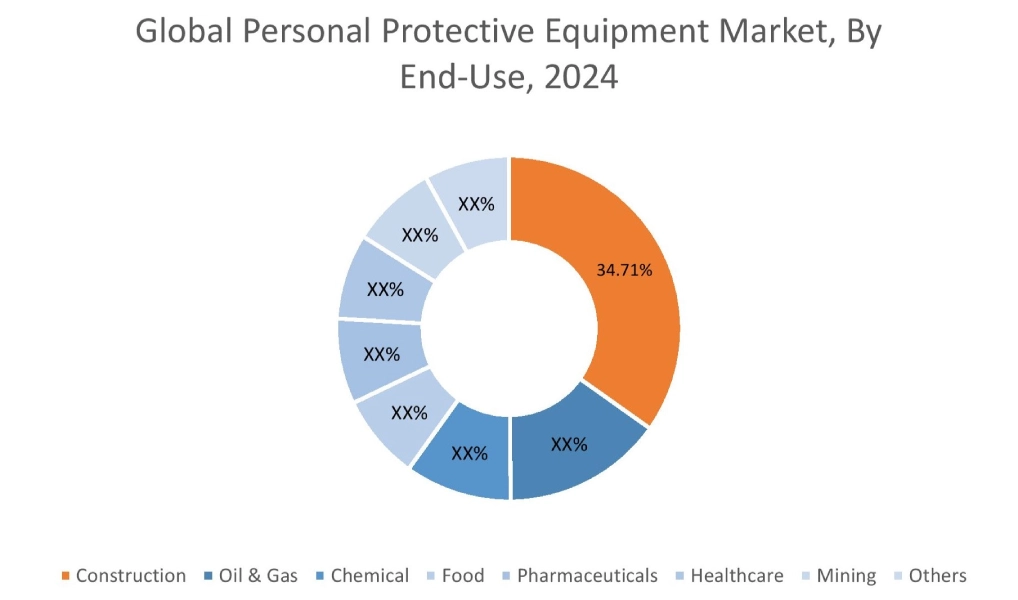
Regional Analysis:
The regional segment includes North America, Europe, Asia Pacific, the Middle East and Africa, and Latin America.
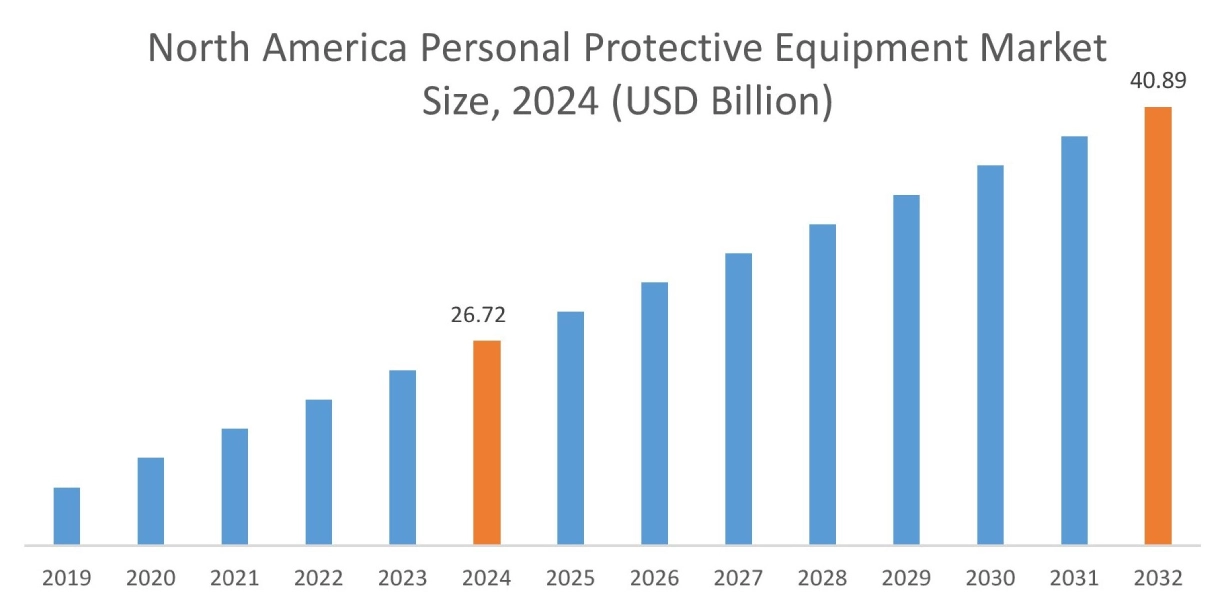
In 2024, North America accounted for the highest personal protective equipment market share at 39.56% and was valued at USD 26.72 Billion and is expected to reach USD 40.89 Billion in 2032. In North America, the U.S. accounted for the personal protective equipment market share of 73.06% during the base year of 2024. There is rapid expansion in the construction industry. The is driven by substantial investments in infrastructure and more government initiatives. Regulations from bodies such as occupational safety and health administration are enforcing the use of personal protective equipment. Moreover, the adoption of advanced PPE solutions is further boosting the market across the region.
For instance,
- In 2025, Kevy Safety launched a hard hat designed for tradespeople. It offers a combination of protection, comfort, and durability. The Kevy hard hat is made with Kevlar and carbon fiber for a lightweight yet tough shell.
Overall, the expanding construction sector and adoption of advanced protection equipment solutions is driving the market in the region.
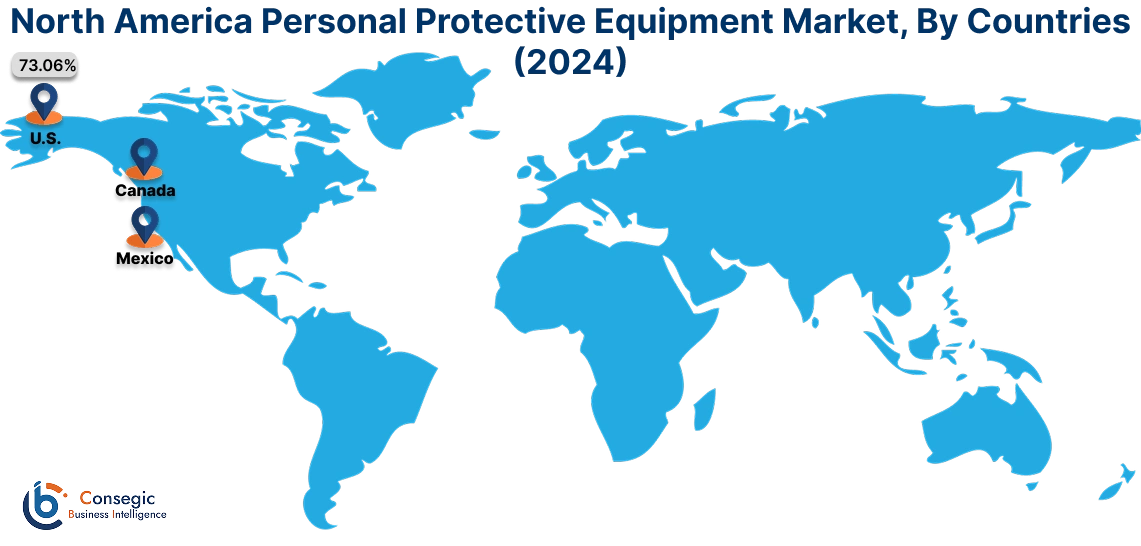
In Asia Pacific, the personal protective equipment market is experiencing the fastest growth with a CAGR of 9.3% over the forecast period. There is a growing awareness of workplace safety in the region. This shift is a result of stricter government regulations placed by governments. Moreover, there is a broader understanding in both employers and the workforce about the critical importance of a safe working environment, hence driving the market. Additionally, rising financial costs are increasing due to the occupational fatalities. This has prompted companies to invest proactively in preventative measures, further boosting the market.
Europe's personal protective equipment market analysis indicates that several key trends are contributing to its growth. There is a booming automotive manufacturing sector in the region. This directly translates into an increased demand for PPE. Automotive plants involve various hazardous operations. This includes welding, painting, heavy machinery operation, and assembly among others. Workers require this equipment for protection against fumes, sparks and splashes. They are also helpful in providing protection from noisy machinery.
Middle East and Africa (MEA) market analysis indicates that there is a rising healthcare industry in the region. This growth is fueled by increasing government investments in healthcare infrastructure, a rising population, and a growing prevalence of chronic diseases. New hospitals, clinics, and research facilities are being built, and existing ones are being modernized. This has driven the need for medical-grade protective equipment such as surgical masks, respirators, disposable gloves, protective gowns, and eye protection surges.
Latin America's region creates potential for the market. The is rise of specialized and niche personal protective equipment products. Industries across the region such as mining, oil & gas, and renewable energy are becoming more complex. This requires highly specific protection. Moreover, the new equipment developed includes vibration gloves for power tool users and flame-retardant clothing for oil rig workers. It also includes specialized respiratory protection for chemical handling and advanced fall protection systems for complex construction sites.
Top Key Players and Market Share Insights:
The Personal Protective Equipment market is highly competitive with major players providing products to the national and international markets. Key players are adopting several strategies in research and development (R&D) and product innovation to hold a strong position in the global Personal Protective Equipment market. Key players in The Personal Protective Equipment industry include-
- 3M (United States)
- Delta Plus Group (France)
- Sioen Industries (Belgium)
- Mallcom India, Ltd. (India)
- Stryker Corporation (United States)
- Honeywell International, Inc. (United States)
- Uvex Safety Group (Germany)
- DuPont de Nemours, Inc. (United States)
- Ansell Limited (Australia)
- MSA Safety, Inc. (United States)
Recent Industry Developments :
Product Launch:
- In 2025, Kask launched Zenith X MAX safety helmet. is designed for a wider range of head sizes (up to 66 cm) than traditional helmets, which typically max out at 63 cm. It features a larger external and internal shell and a longer chinstrap for a more comfortable and secure fit for individuals with larger head sizes.
- In 2024, Bolle Safety launched the SWIFT industrial collection. It includes both safety glasses and over-the-glasses (OTG) goggles. It has an eco-friendly range designed for industrial professionals. It offers a blend of style, performance, and affordability. The SWIFT collection is made with 31% recycled polycarbonate and is fully recyclable.
Personal Protective Equipment Market Report Insights :
| Report Attributes | Report Details |
| Study Timeline | 2019-2032 |
| Market Size in 2032 | USD 114.28 Billion |
| CAGR (2025-2032) | 6.8% |
| By Product Type |
|
| By End Use |
|
| By Region |
|
| Key Players |
|
| North America | U.S. Canada Mexico |
| Europe | U.K. Germany France Spain Italy Russia Benelux Rest of Europe |
| APAC | China South Korea Japan India Australia ASEAN Rest of Asia-Pacific |
| Middle East and Africa | GCC Turkey South Africa Rest of MEA |
| LATAM | Brazil Argentina Chile Rest of LATAM |
| Report Coverage |
|
Key Questions Answered in the Report
How big is the Personal Protective Equipment market? +
In 2024, the Personal Protective Equipment market is USD 67.54 Billion.
Which is the fastest-growing region in the Personal Protective Equipment market? +
Asia Pacific is the fastest-growing region in the Personal Protective Equipment market.
What specific segmentation details are covered in the Personal Protective Equipment market? +
Product Type and End-Use segmentation details are covered in the Personal Protective Equipment market.
Who are the major players in the Personal Protective Equipment market? +
3M (United States), Honeywell International, Inc. (United States), Uvex Safety Group (Germany), DuPont de Nemours, Inc. (United States), and Ansell Limited (Australia) are some major players in the market.
